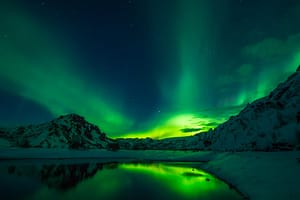Air
Iceland has an extensive network of domestic flights, which locals use almost like buses. In winter a flight can be the only way to get between destinations, but weather at this time of year can play havoc with schedules.
Domestic flights depart from the small Reykjavík Domestic Airport, not from the major international airport at Keflavík.
A handful of airstrips offer regular sightseeing flights – eg Mývatn, Skaftafell, and Reykjavík and Akureyri domestic airports – and helicopter sightseeing is increasingly popular.
A list of local airports and useful information about them is found at www.isavia.is.
Bicycle
Cycling is an increasingly popular way to see the country’s landscapes, but cyclists should be prepared for harsh conditions. Gale-force winds, driving rain, sandstorms, sleet and sudden flurries of snow are possible year-round. We recommend keeping your plans relatively flexible so you can wait out bad weather if the need arises.
You’ll be forced to ride closely alongside traffic on the Ring Road (there are no hard shoulders to the roads).
The large bus companies carry bikes, so if the weather turns bad or that highlands bike trip isn’t working out as planned, consider the bus. Note that space can’t be reserved. It’s free to take a bike on Strætó services; other companies, such as SBA-Norðurleið and Reykjavík Excursions, charge 4000kr, and it’s advisable to contact them regarding rules and space.
Boat
Several year-round ferries operate in Iceland. Major routes all carry vehicles, but it’s worthwhile booking ahead for car passage.
Herjólfur (www.seatours.is) Connecting Landeyjahöfn in South Iceland to Vestmannaeyjar islands.
Sævar (www.hrisey.is) Frequent, easy connections from Árskógssandur in North Iceland, north of Akureyri, to the island of Hrísey.
Baldur (www.seatours.is) Connecting Stykkishólmur in West Iceland to Brjánslækur in the Westfjords, via the island of Flatey.
Sæfari (www.saefari.is) Connecting Dalvík in North Iceland to Grímsey island on the Arctic Circle.
From June to August, regular boat services run from Bolungarvík and Ísafjörður to points in Hornstrandir (Westfjords).
Bus
Iceland has a shrinking network of long-distance bus routes, with services provided by a handful of main companies. The free Public Transport in Iceland map has an overview of routes; pick it up at tourist offices or view it online at www.publictransport.is.
From roughly June to August, regular scheduled buses run to most places on the Ring Road, into the popular hiking areas of the Southwest, and to larger towns in the Westfjords and Eastfjords, and on the Reykjanes and Snæfellsnes Peninsulas. The rest of the year, services range from daily, to a few weekly, to nonexistent.
Many bus services can be used as day tours: buses spend a few hours at the final destination before returning to the departure point, and may stop for a half-hour at various tourist destinations en route.
Bus companies may operate from different terminals or pick-up points. Reykjavík has several bus terminals; in small towns, buses usually stop at the main petrol station or camping ground, but it pays to double-check.
Car & Motorcycle
Driving in Iceland gives you unparalleled freedom to discover the country and, thanks to (relatively) good roads and (relatively) light traffic, it’s all fairly straightforward.
The Ring Road (Rte 1) circles the country and is paved.
Beyond the Ring Road, fingers of sealed road or gravel stretch out to most communities.
Driving coastal areas can be spectacularly scenic, and incredibly slow as you weave up and down over mountain passes and in and out of long fjords.
A 2WD vehicle will get you almost everywhere in summer (note: not into the highlands, or on F roads).
In winter heavy snow can cause many roads to close; mountain roads generally only open in June and may start closing as early as September. For up-to-date information on road conditions, visit www.road.is.
Don’t be pressured into renting a GPS unit – if you purchase a good, up-to-date touring map, and can read it, you should be fine without GPS. If you are planning to take remote trails, a GPS will be worthwhile.
Campervan Hire
Combining accommodation and transport costs into campervan rental is a booming option – and has extra appeal in summer, as it allows for some spontaneity (unlike every other form of accommodation, campsites don’t need to be prebooked). Travelling by campervan in winter is possible, but we don’t recommend it – there are fewer facilities open for campers at this time, and weather conditions may make it unsafe.
There are dozens of companies that can help you get set up. As with rental cars, prices vary depending on size and age of the vehicle, length of rental period, high/low season, added extras etc. Shop around, and read the fine print. Prices for something small and basic can start at around 12,000kr per day.

